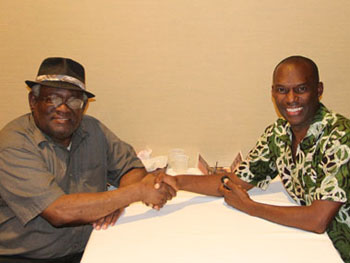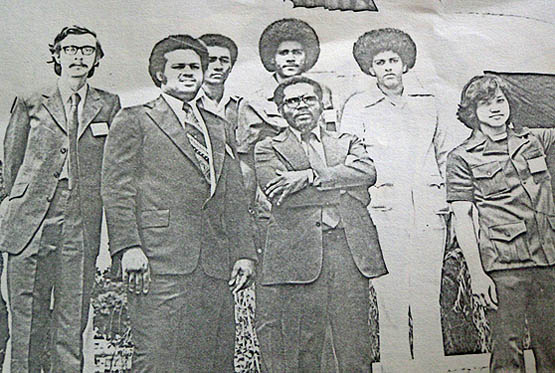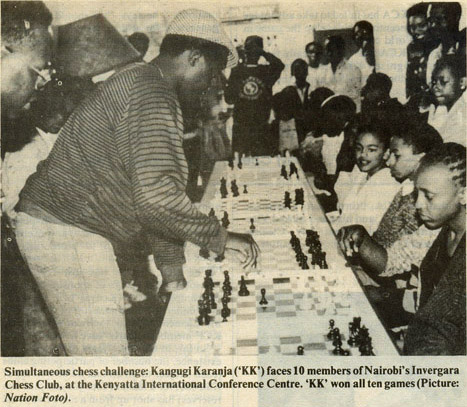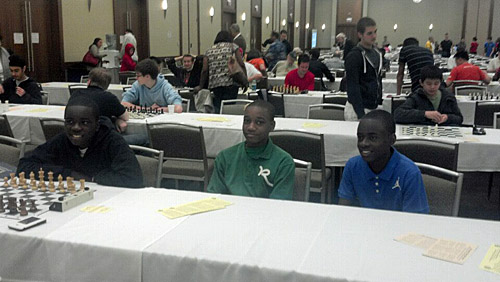Rare Chess Images in Black History
Over the 12 years of its existence (February 12, 2001), The Chess Drum has brought many stories Black History Month. There have been many essays and even quizzes! This year we will provide more imagery than words. The history of Black Chess is replete with so many interesting stories, many yet untold. In the coming years, more history will be made on these pages, but we always have understand those upon whose shoulders we stand.

Walter Harris (left), the first Black National Master in the U.S.
Part of the mission of The Chess Drum is to show the contributions made by players of the African Diaspora and show the universality of chess. As we have seen in the fascinating stories of “The Queen of Katwe” and “Brooklyn Castle” there are many stories that would not otherwise see the light of day. This is why it is important to give players well-deserved recognition for their contributions.
In the history of chess, we have to take pride in knowing that the game has gained a following in many countries, but particularly those in places where a chess tradition does not exist. Many players were influenced by the “Fischer Boom” of the 70s. Bobby Fischer single-handedly popularized chess and made it appealing to millions around the globe. The wave hit the Black community as many of the National Masters emerged in the 80s, within a few years after taking up the game. However, you have a few trailblazers.
One happened to have been a Fischer contemporary and he would become the first Black National Master. Walter Harris (pictured at the top and below) was a sensation in the turbulent 1960s. A former Air Force Airman, Harris created a stir after surging at the top of the charts in the 1959 U.S. Junior Open. He ultimately placed 5th with 6/9. He would go off to UCLA to study and later embarked on a career in physics. Today he lives in Virginia.
.jpg)
In an interview conducted by The Chess Drum in 2005, Harris recounted the following story.
During our conversation about the 1959 U.S. Open, Harris mentioned a story about not being able to rent a room at a hotel because he was Black. He could not remember if this incident occurred at the same hotel where the tournament was being held (Sheraton- Fontenelle Hotel). In those days, segregation ruled the day and Blacks were not allowed access to public facilities. The managers had pulled Anthony Saidy (now an IM) aside and told him that Harris was not welcome. Saidy protested, but the hotel managers were adamant. They went to another hotel where they were able to find accommodations.
It was this tense environment that he had to endure and he recounted the loneliness of Black players in those days. However, the 60s would produce the likes of Frank Street and Kenneth Clayton, the 2nd and 3rd National Masters. Players such as GM Maurice Ashley and IM Emory Tate stand on the shoulders of these three men.
While history was being made in the U.S., it was also made in other countries. The seed of chess enthusiasm began to sprout in Jamaica. According to Ian Wilkinson, the Jamaican Chess Federation was officially founded on 22nd February, 1969 by the late Enos Ayrton Grant, a prominent lawyer and chess visionary who was elected the first President and the late John Powell. The JCF was officially recognized by FIDE in 1972.

Jamaica’s team at the opening ceremony of the 23rd World Students’ Chess Olympiad in Caracas, Venezuela, 7-22 August, 1976. From left: Bob Wheeler, John Powell (deceased), Peter Mundell, David Hunt (deceased), Enos Grant (Captain/delegate, deceased), Orrin Tonsingh (deceased), and Sheldon Wong. Photo from Jamaica Ambassadors Chess Academy.
Of course Africa certainly had its own renaissance as countries in the English-speaking countries began to take up chess after draughts had taken hold in the French-speaking countries. One of the countries having collected rare images of their historic moments is Kenya. Some time ago, Kim Bhari made rare images and newsletters available for public viewing.

The photo below is actually of an New York-born prodigy of Kenyan parents named Kangugi “KK” Karanja. KK was known as a child prodigy having achieved success at an early age in U.S. scholastic tournaments. Holding dual citizenship, he would on occasion visit his ancestral land and give exhibitions. While there are many today who were not present to see the rise of KK Karanja and Baraka Shabazz, their short bursts into prominence provides instructive examples of how hard work is rewarded.
.jpg)
Baraka Shabazz’s charm and angelic face belied her ferocity over the board. Read more about her story as the “Black Queen of Chess“.
While there are many rare images, there are some that will not be deemed important until many years later. One thing is for sure is the emergence of new talent and thus new history being made. The Chess Drum commends chess players for their contributions to the chess community and to those experiences that are unique to those of African descent. The aforementioned “The Queen of Katwe” and “Brooklyn Castle” provide us with an inkling of how such chess experiences can unfold and how they can have such a big impact for generations to come!

National Masters Justus Williams, James Black, Jr. and Josh Colas represent the next generation of history makers. Photo by Guy Colas.

Can you name these players? 🙂
Thanks for this piece of history!
I recognize Stephen Muhummad and of course you Daaim ! The others I don’t.
The others are Masters.
Is that Sulaiman Smith next to you?
Yep! That’s the man. 🙂
I thought they was the Five Deadly Venoms. LOL… for those that don’t know what I’m talking about, google ” 5 Deadly Venoms”
Good shot of you guys…..
Quentin
Left to right:
– NM Elvin Wilson. Former US high school co-champion (1988?), former US Armed Forces champion.
– IM Stephen Muhammad.
– LM Leonard Dickerson. Three-time TN state champion.
– Sulaiman Smith (Georgia expert).
– Some guy with a chess website.
😀
Boyd… you’re on point! (almost)
Sulaiman Smith made Master, but like many he has tumbled below 2200 with infrequent play. He is proud of his Master’s Certificate and he always offers me a copy of it. 🙂
I’m going to put up another picture.
Argh. You’re right about Smith, of course. Still, I don’t think I did so bad, working from memory. 🙂
Can you name these players? 🙂
Okay, this one is a little tougher. 🙂 I might miss as many as three here.
Front row, left to right:
FM William Morrison.
NM David Allen, Sr. (1)
Daaim Shabazz.
David Allen, Jr.
NM Sulaiman Smith. (2)
Back row, left to right:
Not sure…NM Charles Covington, maybe?
NM Frank Street. (3)
FM Emory Tate. (4)
GM Maurice Ashley.
Not sure…looks for all the world like NM Shearwood McClelland III, but I haven’t seen him at a tournament in ages, and I’m guessing this photo was taken at a World Open.
IM Kenny Solomon.
No idea on the next person.
NM Ernest Colding. (5)
Notes:
(1) I finally met David Allen, Sr. at the 2012 Ohio Chess Congress. Brilliant man. If you have time, Daaim, you should profile his younger sons, Jason and Jonathan Clinton.
(2) I hope this makes up for missing his proper title before. 🙂
(3) There aren’t many things that make Bill Goichberg do a double-take. Seeing Frank Street signed up for a blitz tournament at the World Open a few years back did the trick.
(4) Someone should do a book on Emory Tate. Would make for fascinating reading.
(5) Met Ernest Colding at the 2012 World Open. Another extremely smart fellow. He’s got some unique ideas.
Wow Boyd, you’re in beast mode! It is a classic shot. The two players you don’t have are also very important. One of them is an African national. The other a Caribbean national. 😉
I confess, I have no earthly idea who the other players are. Frankly, I’m a bit surprised I got Covington right. 🙂
The simple truth is, I wouldn’t recognize about half of the people I got right if it weren’t for this site. Thanks for all the work you do.
The player in the checkered shirt is National Master Grace Nsubuga of Uganda. He was in town for the World Open, Wilbert Paige and also played in the U.S. Open in Boston.
The player with the glasses… I’ll leave for someone else. I’m sure someone will know.
Jones Murphy, the chief financier of the Wilbert Paige Memorial. An absolutely brilliant man with a Ph.D. in Physics and hailing from the island of Dominica.